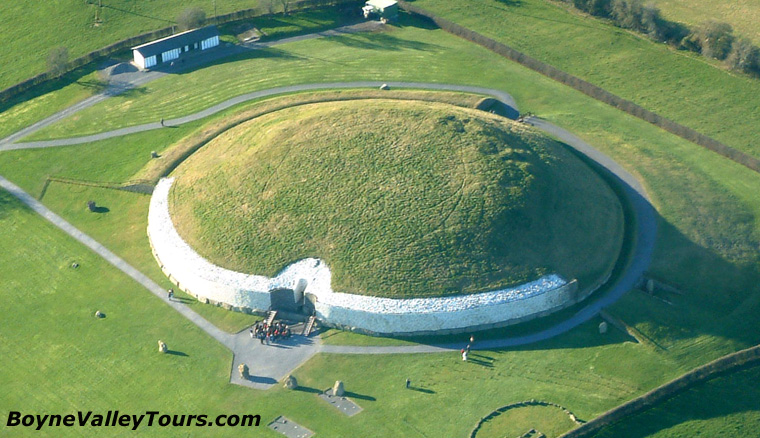The UNESCO World Heritage site Newgrange is a Stone Age monument located in the Boyne Valley, County Meath, in Ireland's Ancient East. It was built about 3,200 BC (5,200 years ago) during the Neolithic period, which makes it older than Stonehenge and the Egyptian pyramids. Newgrange is a large circular mound with a stone passageway and chambers inside. The mound is ringed by large stones known as kerbstones some of which are engraved with artwork.
Archaeologists classified Newgrange as a passage tomb, however Newgrange is now recognised to be much more than a passage tomb. Ancient Temple is a more fitting classification, a place of astrological, spiritual, religious and ceremonial importance.
The passage and chamber is aligned with the rising sun on the mornings around the winter solstice. It is the best know monument within the Brú na Bóinne complex, alongside the similar passage tomb mounds of Knowth and Dowth, and as such is a part of the Brú na Bóinne UNESCO World Heritage Site. Newgrange also shares many similarities with other passage tombs in Western Europe, such as Gavrinis in Brittany, Maeshowe in Orkney and Bryn Celli Ddu in Wales.
After its initial use, Newgrange was sealed and it remained so until the passage and chamber were rediscovered in 1699. In the 1970s, the front of the monument was reconstructed.
The Neolithic people who built the monument were farmers, growing crops and raising animals such as cattle in the area where their settlements were located; they had not yet developed metal, so all their tools would have been made out of stone, wood, antler or bone.
The Mound and Passage Tomb
The Newgrange monument primarily consists of a large mound, built of alternating layers of earth and stones, with grass growing on top and a reconstructed facade of white quartz stones studded at intervals with rounded cobbles covering part of the circumference. The mound is 85m (279ft) across and 13m (43ft) high, and covers 4,500 sq.m (1 acre) of ground.Within the mound is a chambered passage, which can be accessed by an entrance on the south-eastern side of the monument. The passage stretches for 19m (63ft), or about a third of the way into the centre of the structure. At the end of the passage are three small chambers off a larger central chamber, with a high corbelled vault roof. Each of the smaller chambers has a large flat "basin stone", which was where the bones of the dead were probably deposited. The walls of this passage are made up of large stone slabs, twenty-two of which are on the west side and twenty-one on the east, which average out at 1.5 metres in height; many are decorated with carvings. Situated around the perimeter of the mound is a circle of standing stones, which archaeologists regard as having been later, during the Bronze Age, centuries after the original monument had been abandoned as a tomb.
Megalithic Art
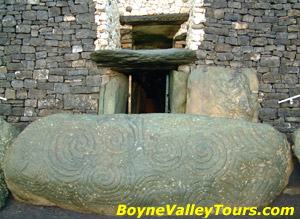 Newgrange
contains various examples of Megalithic Art including circles, spirals, arcs, chevrons and lozenges, radials.
One of the most notable examples of art at Newgrange is the triskele-like features found on the entrance stone.
It is about 3m (10ft) long and 1.2m (4ft) high and about 5 tonnes in weight. It has been described as "one of the most
famous stones in the entire repertory of megalithic art." Archaeologists believe that most of the carvings
were produced prior to the stones being erected in place, although the entrance stone was instead carved
in situ before the kerbstones were placed alongside it.
Newgrange
contains various examples of Megalithic Art including circles, spirals, arcs, chevrons and lozenges, radials.
One of the most notable examples of art at Newgrange is the triskele-like features found on the entrance stone.
It is about 3m (10ft) long and 1.2m (4ft) high and about 5 tonnes in weight. It has been described as "one of the most
famous stones in the entire repertory of megalithic art." Archaeologists believe that most of the carvings
were produced prior to the stones being erected in place, although the entrance stone was instead carved
in situ before the kerbstones were placed alongside it.
Various archaeologists have speculated as to the meaning of the decoration. George Coffey who produced a study of art at New Grange in the 1890s believed them to be purely decorative, whilst others, like Michael J. O'Kelly who led the 1962-1975 excavation at the site, believed them to have some sort of symbolic purpose because some of the carvings had been in places that would not have been visible, such as at the bottom of the orthostatic slabs below ground level.
Newgrange Construction
The complex of Newgrange was originally built about 3200BC, making it over 5,000 years old. According to carbon-14 dates it is about five hundred years older than the current form of Stonehenge, and the Great Pyramid of Giza in Egypt, as well as predating the Mycenaean culture of ancient Greece. Geological analysis indicates that much of building materials used to construct Newgrange was greywacke stone from the rocky beach at Clogherhead, Co Louth, approx. 20 km to the north-east. The greywacke stone blocks were possibly transported to the Newgrange site by sea and up the River Boyne by securing them to the underside of boats at low tide.None of the structural slabs were quarried, for they show signs of having been naturally weathered, but they must have been collected and then transported somehow largely uphill to the Newgrange site. Meanwhile, the stones used for the cairn, which together would have weighed around 200,000 tonnes, were likely taken from the river terraces between Newgrange and the Boyne, and there is indeed a large pond in this area which has been speculated was the site quarried out by Newgrange's builders to use for material for the cairn. Professor Frank Mitchell suggested that the monument could have been built within a space of five years, basing his estimation upon the likely number of local inhabitants during the Neolithic and the amount of time they would have devoted to building it rather than farming. This estimate was however criticised by Michael J. O'Kelly and his archaeological team, who believed that it would have taken a minimum of thirty years to build.
Burials
Excavations have revealed deposits of both burnt and unburnt human bone in the passage, indicating human corpses were indeed placed within it, some of which had been cremated. From examining the unburnt bone, it was shown to come from at least two separate individuals, but much of their skeletons were missing, and what was left had been scattered about the passage. Various grave goods were deposited alongside the bodies inside the passage. Excavations that took place in the late 1960s and early 1970s revealed seven 'marbles', four pendants, two beads, a used flint flake, a bone chisel and fragments of bone pins and points. Many more artefacts were found in the passage in previous centuries by visiting antiquarians and tourists, although most of these were removed and missing or were held in private collections. Nonetheless, these were sometimes recorded, and it is believed that the grave goods that came from Newgrange were typical of Neolithic Irish passage grave assemblages.Purpose of Newgrange
There have been various debates as to its original purpose. Many archaeologists believed that the monument had religious significance of some sort or another, either as a place of worship for a "cult of the dead" or for an astronomically-based faith.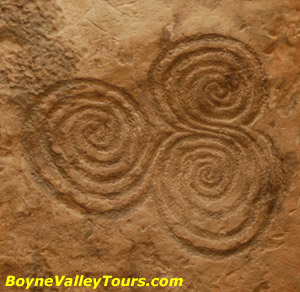 The
archaeologist Michael J. O'Kelly, who led the 1962-1975 excavations at the site, believed
that the monument had to be seen in relation to the nearby
Knowth and Dowth,
and that the building of Newgrange "cannot be regarded as other than
the expression of some kind of powerful force or motivation, brought
to the extremes of aggrandizement in these three monuments, the
cathedrals of the megalithic religion." O'Kelly believed that
Newgrange, alongside the hundreds of other passage tombs built
in Ireland during the Neolithic, showed evidence for a religion
which venerated the dead as one of its core principles. He
believed that this "cult of the dead" was just one particular
form of European Neolithic religion, and that other megalithic
monuments displayed evidence for different religious beliefs
which were solar, rather than death-orientated.
The
archaeologist Michael J. O'Kelly, who led the 1962-1975 excavations at the site, believed
that the monument had to be seen in relation to the nearby
Knowth and Dowth,
and that the building of Newgrange "cannot be regarded as other than
the expression of some kind of powerful force or motivation, brought
to the extremes of aggrandizement in these three monuments, the
cathedrals of the megalithic religion." O'Kelly believed that
Newgrange, alongside the hundreds of other passage tombs built
in Ireland during the Neolithic, showed evidence for a religion
which venerated the dead as one of its core principles. He
believed that this "cult of the dead" was just one particular
form of European Neolithic religion, and that other megalithic
monuments displayed evidence for different religious beliefs
which were solar, rather than death-orientated.
However studies in other fields of expertise offer alternative interpretations of the possible functions, which principally centre on the astronomy, engineering, geometry and mythology associated with the Boyne monuments. It is speculated that the sun formed an important part of the religious beliefs of the neolithic ("New" Stone Age) people who built it. One idea was that the room was designed for a ritualistic capturing of the sun on the shortest day of the year, the Winter Solstice, as the room gets flooded with sunlight, which might have helped the days start to get longer again. This view is strengthened by the discovery of alignments in Knowth, Dowth and the Loughcrew Cairns leading to the interpretation of these monuments as calendrical or astronomical devices.
Formerly the Newgrange mound was encircled by an outer ring of immense standing stones, of which twelve of a possible thirty-seven remain. However, evidence from carbon dating suggests that the stone circle which encircled Newgrange may not be contemporary with the monument itself but was placed there some 1,000 years later in the Bronze Age. This view is disputed and relates to a carbon date from a standing stone setting which intersects with a later timber post circle, the theory being that the stone in question could have been moved and re-set in its original position at a later date. This does however show a continuity of use of Newgrange of over a thousand years; with partial remains found from only five individuals, the tomb theory is called into question.
Winter Solstice
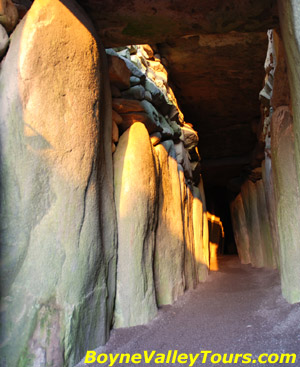 On
the mornings around the winter solstice, the rising sun shines directly along the long passage
into the chamber for about 17 minutes and illuminates the chamber floor. Professor
Michael J. O'Kelly was the first person in modern times to observe this event on
21st December 1967. The sun enters the passage through a specially contrived opening,
known as a roofbox, directly above the main entrance. Although solar alignments are
not uncommon among passage graves, Newgrange is one of few to contain the additional roofbox feature.
On
the mornings around the winter solstice, the rising sun shines directly along the long passage
into the chamber for about 17 minutes and illuminates the chamber floor. Professor
Michael J. O'Kelly was the first person in modern times to observe this event on
21st December 1967. The sun enters the passage through a specially contrived opening,
known as a roofbox, directly above the main entrance. Although solar alignments are
not uncommon among passage graves, Newgrange is one of few to contain the additional roofbox feature.
The alignment is such that although the roofbox is above the passage entrance, the light hits the floor of the inner chamber. Today the first light enters about four minutes after sunrise, but calculations based on the precession of the Earth show that 5,000 years ago first light would have entered exactly at sunrise. The solar alignment at Newgrange is very precise compared to similar phenomena at other passage graves such as Dowth or Maes Howe in the Orkney Islands, off the coast of Scotland.
In 2015 on the night of December 20th the Aurora Borealis (Northern Lights) were clearly visible over Newgrange.
Current-day visitors to Newgrange are treated to a re-enactment of this event through the use of electric lights situated within the tomb. The finale of a Newgrange tour results in every tour member standing inside the tomb where the tour guide then turns off the lights, and lights the light bulb simulating the sun as it would appear on the winter solstice. Anyone visiting the historic site can experience an approximation of the phenomenon any time of year, and is often the highlight of the tour. A lottery is held annually for "tickets" to allow the holder into the tomb to view the actual event. The popularity of this event was the reason a lottery was introduced, and also why the lights were installed.
Mythology and folklore
During the medieval period, Newgrange and the wider Brú na Bóinne Neolithic complex, gained various attributes in local folklore, which was often connected to figures from wider Irish mythology. The monuments of the Brú were thought of by some as being the abode of the supernatural Tuatha De Danann, whilst others considered them to be the burial mounds of the ancient kings of Tara. Amongst those who believed the folkloric tales relating the Brú to the Tuatha De Danann, it was commonly thought that they were the abode of the most powerful of the Tuatha, particularly The Dagda, his wife Boann and his son, Oengus. According to the 11th century Book of Lecan, the Dagda had built the Brú for himself and his three sons, whilst the 12th century Book of Leinster describes how Oengus tricked his father into giving him the Brú for all eternity. Another text, The Pursuit of Diarmaid and Grainne also implies that Oengus owned the Brú, when he declared how he took his friend Diarmaid to it.The name "Newgrange"
In the 12th century mound and the land around it become part of outlying farmland owned by the Cistercian Abbey of Mellifont. These farms were referred to as 'granges'. By 1378 it was simply called 'the new grange'.Newgrange in the 17th and 18th centuries
In 1699, a local landowner, Charles Campbell, ordered some of his farm labourers to dig up a part of Newgrange, which then had the appearance of a large mound of earth, so that he could collect stone from within it. The labourers soon discovered the entrance to the tomb within the mound, and a Welsh antiquarian named Edward Lhwyd, who was staying in the area, was alerted and took an interest in the monument. He wrote an account of the mound and its tomb, describing what he saw as its "barbarous sculpture" and noting that animal bones, beads and pieces of glass had been found inside of it.Soon another antiquarian visitor also came to the site, named Sir Thomas Molyneaux, who was a professor at the University of Dublin. He talked to Charles Campbell, who informed him that he had found the remains of two human corpses in the tomb, something that Lhwyd had not noted. Subsequently, Newgrange was visited by a number of antiquarians, who often performed their own measurements of the site and made their own observations, which were often published in various antiquarian journals; these included such figures as Sir William Wilde, Sir Thomas Pownall, Thomas Wright, John O'Donovan, George Petrie and James Ferguson.
These antiquarians often concocted their own theories about the origins of Newgrange, many of which have since been proved incorrect. Sir Thomas Pownall for instance stated that the mound had originally been much taller but that a lot of the stone on top of it had subsequently been removed, a theory which has subsequently been disproven by archaeological research. The majority of these antiquarians also refused to believe that it was ancient peoples native to Ireland who built the monument, with many believing that it had been built in the early Mediaeval period by invading Vikings, whilst others speculated that it had been actually built by the Ancient Egyptians, ancient Indians or the Phoenicians.
Newgrange in the 19th and 20th centuries
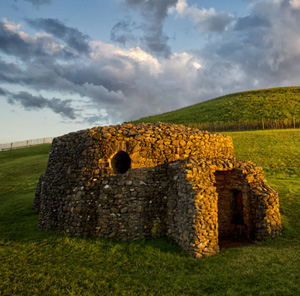 In
the 19th century a folly was constructed a few yards behind Newgrange.
The folly, with two circular windows, was made of stones taken from Newgrange monument.
In 1882, under the Ancient Monuments Protection Act, Newgrange, along with the nearby monuments of
Knowth and Dowth, was taken under
the control of the state (United Kingdom of Great Britain and Ireland, as it was then
known), and they were placed under the responsibility of the Board of Public Works.
In 1890, under the leadership of Thomas Newenham Deane, the Board began a project
of conservation of the monument, which had been damaged through general deterioration
over the previous three millennia as well as the increasing vandalism caused by visitors,
some of whom had inscribed their names on the stones.
In
the 19th century a folly was constructed a few yards behind Newgrange.
The folly, with two circular windows, was made of stones taken from Newgrange monument.
In 1882, under the Ancient Monuments Protection Act, Newgrange, along with the nearby monuments of
Knowth and Dowth, was taken under
the control of the state (United Kingdom of Great Britain and Ireland, as it was then
known), and they were placed under the responsibility of the Board of Public Works.
In 1890, under the leadership of Thomas Newenham Deane, the Board began a project
of conservation of the monument, which had been damaged through general deterioration
over the previous three millennia as well as the increasing vandalism caused by visitors,
some of whom had inscribed their names on the stones.
In subsequent decades, a number of archaeologists performed excavations at the site, discovering more about its function and how it had been constructed; however, even at the time, it was still widely believed by archaeologists to be Bronze Age in origin rather than the older Neolithic. In the 1950s, electric lighting was installed in the passageway to allow visitors to see more clearly, whilst an exhaustive archaeological excavation was undertaken from 1962 through to 1975, the excavation report of which was written by Michael J. O'Kelly and published in 1982 as Newgrange: Archaeology, Art and Legend.
Following this excavation, further restoration took place at the site. As a part of the restoration process the white quartz stones and cobbles were fixed into a near-vertical concrete wall surrounding the entrance of the mound. This restoration is controversial among the archaeological community. Critics of the wall point out that the technology did not exist when the mound was created to fix a retaining wall at this angle. Another theory is that the white quartz stones formed a plaza on the ground at the entrance.
Access to Newgrange
Access to Newgrange is by guided tour only. Tours begin at the Brú na Bóinne Visitor Centre from which visitors are bussed to the site in groups of up to 24 per shuttle bus. To experience the phenomenon on the morning of the Winter Solstice from inside Newgrange, one must enter a lottery at the interpretive centre. At the end of September each year, 50 names are drawn by local school children, 10 names for each morning the chamber is illuminated, 2 places in the chamber are awarded to each of the lottery winners. A reserve list is also drawn, the reserve list is there in case someone whose name is drawn for the initial list is not contactable or else finds it impossible to travel to Newgrange on the date they have been assigned. Places allocated by lottery are non-transferable. Lottery winners cannot offer their place in the chamber to someone else.Early 20th Century Visitors
John L. Stoddard published an account of his visit to Newgrange and the Hill of Tara in 1901 More ...A Boyne Valley Tour as described by Burton E. Stevenson in his book 'The Charm of Ireland', published in 1914. More ...
Private Tour to Newgrange, Knowth, and the Boyne Valley
Embark on a journey through time and heritage with our exclusive private tour to Newgrange, Knowth, and other captivating sites nestled in the enchanting Boyne Valley. Immerse yourself in the rich history and mystique of these World Heritage sites, where ancient wonders come to life.Newgrange and Knowth, both designated as UNESCO World Heritage sites, stand as testament to the ingenuity of our ancestors. Dating back over 5,000 years, these Neolithic passage tombs are older than Stonehenge and the Great Pyramids of Giza. Step inside the chambers of Newgrange, where the winter solstice illuminates a narrow passage, casting an ethereal light on the ancient carvings within. Explore Knowth, adorned with megalithic art, and unravel the mysteries of a bygone era.
Visit the megalithic passage tombs at Newgrange and Knowth with the on-site guide. These are UNESCO World Heritage sites so you will be joining others on the official tour. Beyond the renowned Newgrange and Knowth, our private tour takes you on an intimate exploration of lesser-known gems in the Boyne Valley.
Leave the logistics to us as you embark on a stress-free exploration of the Boyne Valley. Our private tours ensure a personalized and comfortable experience from the moment we pick you up at your accommodation to the time we drop you back.
Make an Inquiry or email BoyneValleyTours@gmail.com
Book a Private Day Tour
Boyne Valley Tours Privacy, Terms and Conditions
Book a Private Day Tour
Boyne Valley Tours Privacy, Terms and Conditions
Home
| Private Driver Tour
| Cruise Excursion
| Places
| Ireland's Ancient East
| About Us
| FAQs
| Contact
| Newgrange
| Knowth
| Hill of Tara
| Monasterboice
| Trim Castle
| Mellifont Abbey
| Slane

